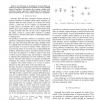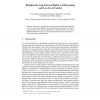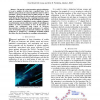2830 search results - page 30 / 566 » Grammar-based robot control |
CIRA
2007
IEEE
15 years 6 months ago
2007
IEEE
— In this paper we investigate how neural fields can produce an elegant solution for the problem of moving multiple robots in formation. The objective is to acquire a target, av...
ICEC
1996
15 years 1 months ago
1996
-- In this paper the results of evolution on the task performance of a robot colony are discussed. The cognitive architecture of individual robots of a colony are modified, using g...
106
click to vote
ICRA
2010
IEEE
14 years 10 months ago
2010
IEEE
— We propose two contrasting approaches to the scalable distributed control of a swarm of self-assembling miniaturized robots, specifically the formation of chains of a desired ...
LPNMR
2009
Springer
15 years 4 months ago
2009
Springer
We present a formal framework where the action description language C+ is used to provide multiple robots with high-level reasoning in the style of cognitive robotics. We show the ...
114
click to vote
IROS
2009
IEEE
15 years 6 months ago
2009
IEEE
—The goal of a robot formation control architecture is to get a number of robots into a specified form. To be effective and practical, the control architecture must be able to tr...



